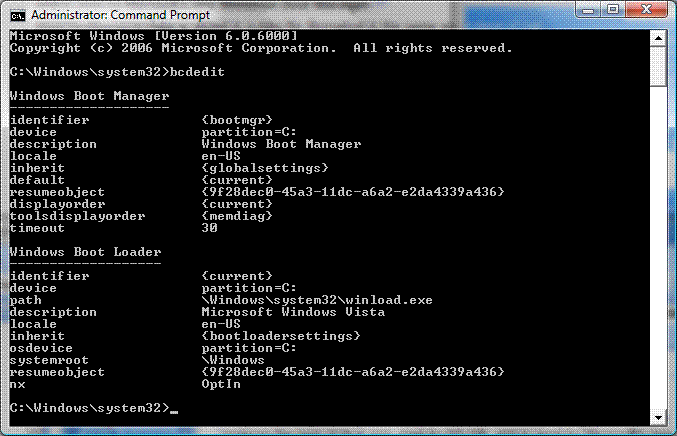Windows Boot Recovery - Fixing Start-up Issues with Windows 10, 8 or 7
Windows 7 onwards uses the Boot Configuration Data (BCD) which is a firmware-independent registry style collection of files for boot-time configuration data. It replaces the boot.ini that was used by NTLDR, and is used by Microsoft's new Windows Boot Manager which replaces NTLDR itself.
Boot Configuration Data is stored in a data file (formatted in the same way as a Windows registry hive) that is located either on the EFI System Partition (on machines that use Extensible Firmware Interface firmware which is an Operating System aware replacement for BIOS and communicates with the OS for things like MBR and ACPI) or in \Boot\Bcd on the system volume (on machines that use IBM PC style firmware).
Boot Configuration Data may be altered using a command-line tool (bcdedit.exe) pictured below:

by using WMI (Windows Management Instrumentation), or with some 3rd party tools.
Boot Configuration Data contain the menu presented by the Windows Boot Manager, just as boot.ini contained the menu entries presented by NTLDR.
To Troubleshoot startup problems by using Windows RE, first try the Startup Repair option in the System Recovery Options dialogue box (if it is present, which it is not in Windows 10). If the Startup Repair option does not resolve the issue, or if you must troubleshoot manually, use the Bootrec.exe tool as described below:
The Bootrec.exe tool is the boot recovery tool in the Windows Recovery Environment (Windows RE) and is used to troubleshoot and repair the:
- Master boot record (MBR)
- Boot sector
- Boot Configuration Data (BCD) store
When you run the Bootrec.exe tool, you must start Windows RE like so:
- Configure the computer to start from the DVD drive in the BIOS.
- Put the Windows installation disc in the disc drive, and then reboot the computer.
- Press a key when you are prompted by the DVD
- Select the relevant language, time, currency and keyboard
- Click Next
- Click Repair your computer.
- Click the operating system that you want to repair,
- Click Next.
- In the System Recovery Options dialog box, click Command Prompt.
Open the command prompt,
Run DISKPART:
Type list disk
Select the disk you wish to boot from - usually the first large disk listed which will have the Windows partition.
Type select disk [disk number] where the disk number is the disk you believe to contain the Windows folder
Next type list partition
Type select partition [partition number] where the partition number is the partition you believe to contain the Windows folder
Type Active to make that partition the active boot partition
Type Exit to leave diskpart
Now find the volume with the WINDOWS folder on it that you wish to boot from.
You can just type sequential drive letters from C: onwards until you find it. It will only be in the first four or five, or something is badly wrong.
Once you have found the Windows Partition you must make that
Type Copy [DVD Drive Letter]:BootMgr c:
If the Boot Manager file already exists, leave it intact, otherwise it will copy to the system disk c:
Run Bootrec /Fixmbr
Run Bootrec /Fixboot which will mand the boot files in place
Lastly run Bootrec /rebuildBCD which will take a minute or two. If this is successful it should ask you if you want to add the Windows installation to the boot record, say YES.
Now type EXIT and you should have an option added to your screen to continue to run Windows
Bootrec.exe optional switches:
/FixMbr
The /FixMbr option writes a Windows Master Boot Record to the system partition. Although this does not overwrite the Master Boot Record in most circumstances, it will fix any nonstandard code in the MBR.
/FixBoot
The /FixBoot option writes a new boot sector to the system partition which will fix the boot files if:
- boot sector has been replaced with a non-standard Windows boot sector.
- The boot sector is damaged.
- An earlier Windows operating system has been installed after Windows was installed; if the system tries to use Windows NT Loader (NTLDR) instead of Windows Boot Manager (Bootmgr.exe).
/ScanOs
The /ScanOs option scans all disks for installations that are compatible with Windows Vista. Additionally, this option displays the entries that are currently not in the BCD store. Use this option when there are Windows Vista installations that the Boot Manager menu does not list.
/RebuildBcd
The /RebuildBcd option scans all disks for installations that are compatible with Windows Vista. Additionally, this option lets you select the installations that you want to add to the BCD store. Use this option when you must completely rebuild the BCD. If rebuilding does not resolve the issue, you can export and delete and then run this option again. By doing this, you make sure that the BCD is completely rebuilt. To do this, type the following:
bcdedit /export C:\BCD_Backup
c:
cd boot
attrib bcd -s -h -r
ren c:\boot\bcd bcd.old
bootrec /RebuildBcd
Windows before Vista and Windows 7 did not use the BCD and Windows BootlLoader, it relied on NTLDR and boot.ini.